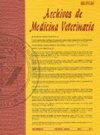墨西哥干旱条件下Pelibuey羊的季节性繁殖活动
Q Veterinary
引用次数: 5
摘要
在墨西哥(32°NL)干旱条件下,将22只在密集条件下饲养的多产Pelibuey母羊与公羊接触并采集一年的血液样本,以评估一年中的季节对发情周期特征、排卵和黄体功能的影响。每天将公羊与母羊一起饲养,观察母羊的发情行为,每周两次单独采血,通过孕酮浓度测定排卵情况。此外,在整个发情周期中每三天单独采集血样以确定黄体功能。每只母羊的发情周期和发情体征根据持续时间分为正常、短、大和多次。各季节母羊的活重(P < 0.05)和体况评分(P < 0.05)保持稳定。夏季和秋季母羊的总发情周期数和正常发情周期数以及每只母羊的总发情体征和正常发情体征数均大于冬季和春季(P < 0.05)。与冬季和春季相比,夏季和秋季母羊单次排卵数较高(P < 0.05),未发母羊比例较低(P < 0.05)。发情周期第5 ~ 14天,秋季黄体酮浓度显著高于冬季和春季(P < 0.05)。综上所述,在北纬32度的墨西哥干旱条件下,Pelibuey母羊在冬春两季的发情和排卵活性下降,黄体功能下降。本文章由计算机程序翻译,如有差异,请以英文原文为准。
Actividad reproductiva estacional de ovejas Pelibuey bajo condiciones áridas de México
SUMMARY Twenty-two multiparous Pelibuey ewes managed under intensive conditions were exposed to rams and used for blood sample collection during one year, to evaluate the effect of season of the year on estrous cycle characteristics, ovulation and corpus luteum functionality under arid conditions in Mexico (32° NL). Rams were daily introduced with ewes to identify estrous behavior, while blood samples were individually collected twice per week to determine ovulation through progesterone concentrations. Additionally, blood samples were individually collected every three days during an overall estrous cycle to determine corpus luteum functionality. Estrous cycles and estrous signs in each ewe were classified based on their duration in normal, short, large, and multiple. Ewes maintained a steady live weight (P > 0.05) and body condition score (P > 0.05) across all seasons. The number of total and normal estrous cycles, as well as the number of total and normal estrous signs per ewe was greater (P < 0.05) in summer and autumn than in winter and spring. Compared with winter and spring, higher (P < 0.05) number of ovulations per ewe and lower (P < 0.05) percentage of ewes with silent estrous were observed in summer and autumn. Progesterone concentrations between days 5 and 14 of the estrous cycle were higher (P < 0.05) in autumn than in winter and spring. In conclusion, under arid conditions of Mexico located at 32 o NL, Pelibuey ewes reduce their estral and ovulatory activity, as well as the corpus luteum functionality in winter and spring seasons.
求助全文
通过发布文献求助,成功后即可免费获取论文全文。
去求助
来源期刊

Archivos De Medicina Veterinaria
农林科学-兽医学
CiteScore
0.38
自引率
0.00%
发文量
0
审稿时长
>36 weeks
期刊介绍:
Archivos de Medicina Veterinaria is published by the Facultad de Ciencias Veterinarias, Universidad Austral de Chile. Archivos de Medicina Veterinaria publishes, in both spanish and english, original scientific contributions containing the latest developments and discoveries in Veterinary Sciences, covering topics such as Animal Health and Production, Animal Welfare, Preventive Medicine, Zoonosis, Pharmacology and Therapeutics, methods of diagnosis and other areas related to Veterinary Science. The journal was founded in 1969 and has 40 years of uninterrupted publishing. Since 2006 it publishes 3 issues per year.
 求助内容:
求助内容: 应助结果提醒方式:
应助结果提醒方式:


